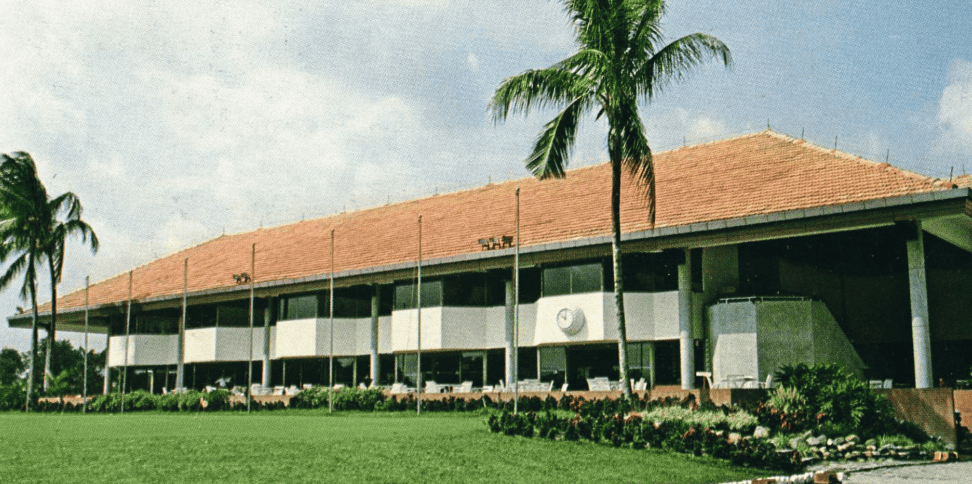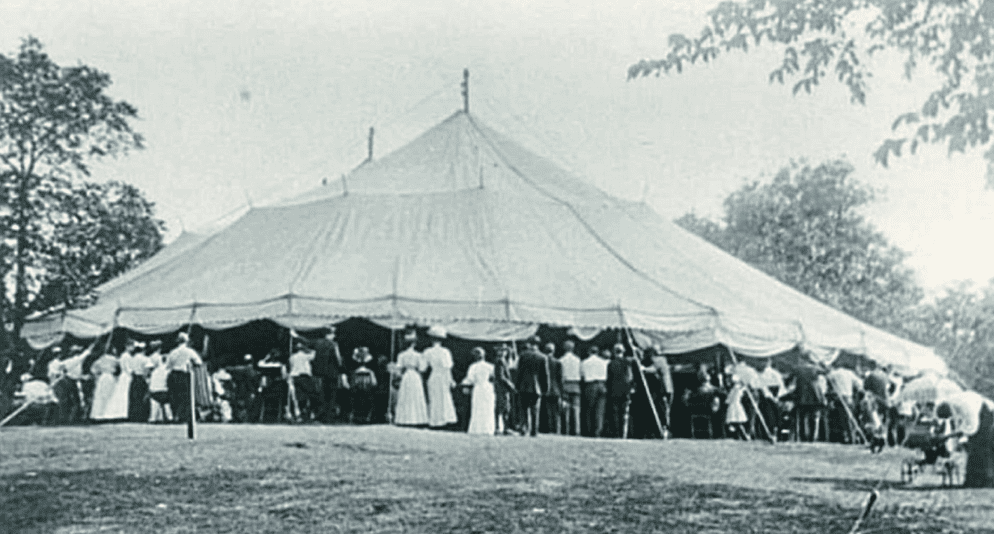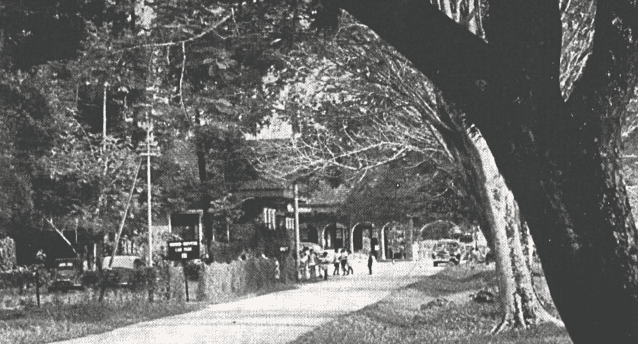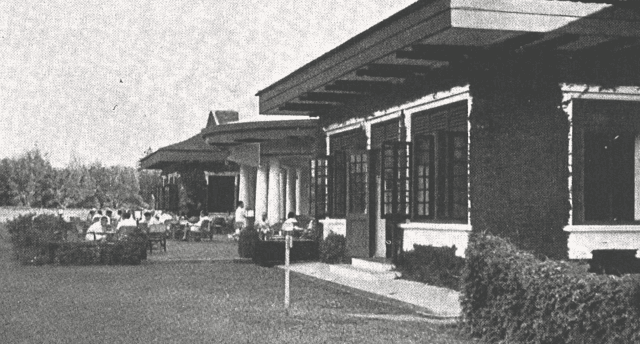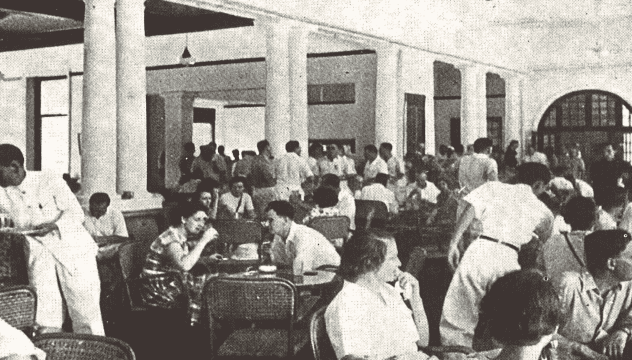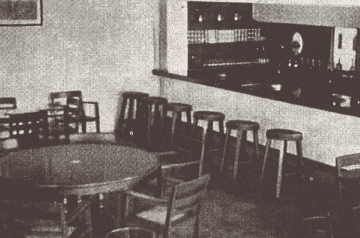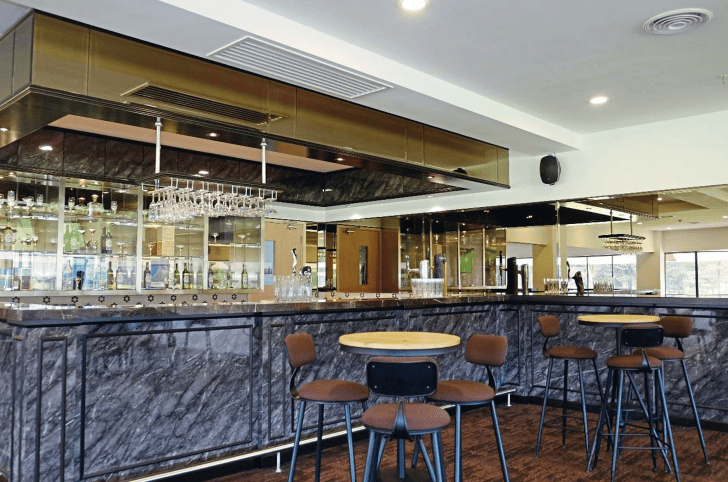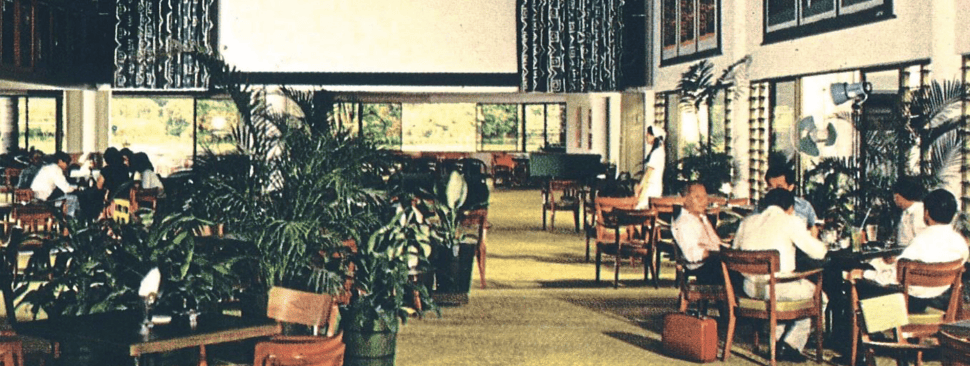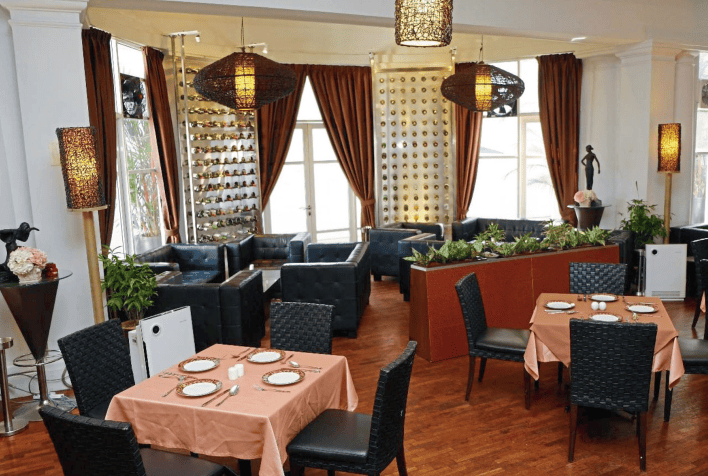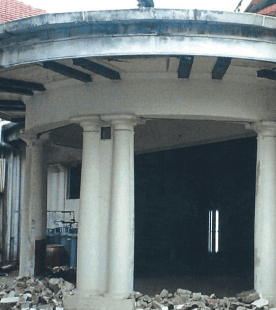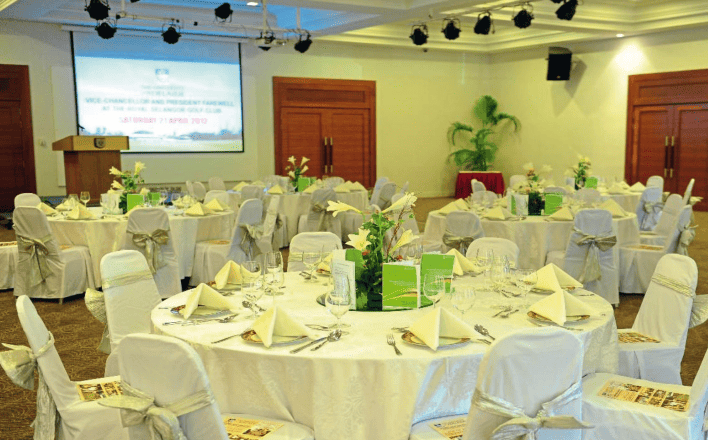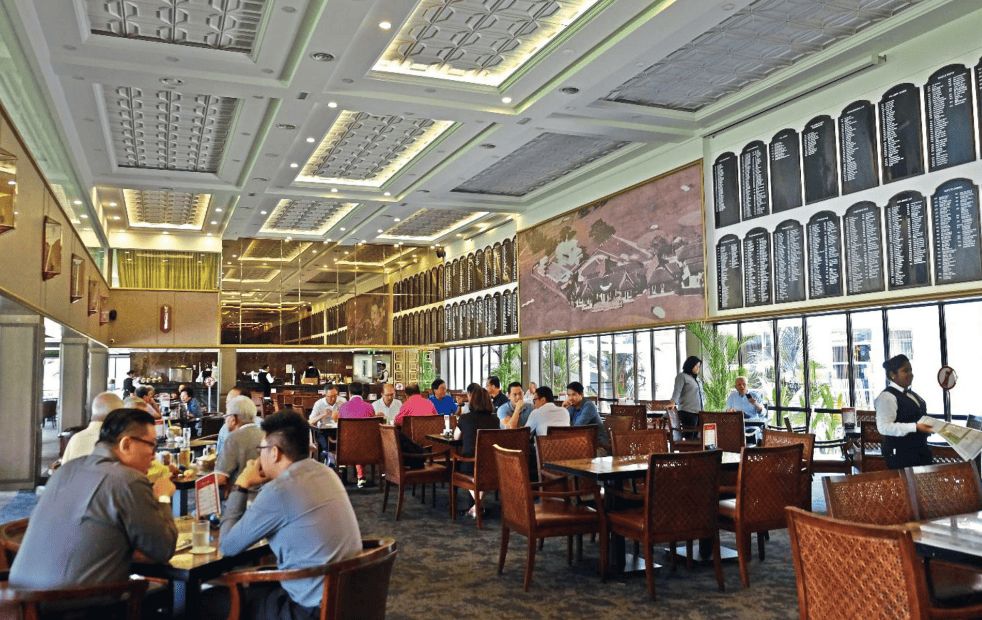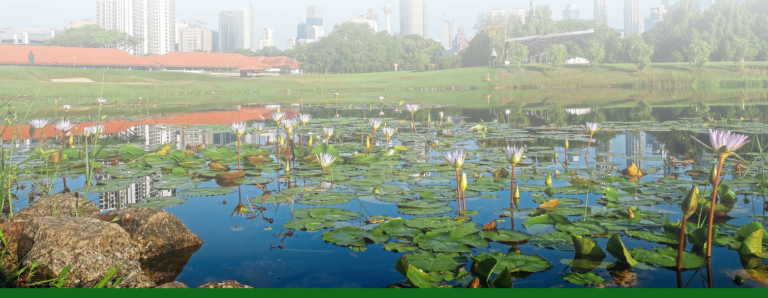From a tentative tent….
A tentative tent like the one above that was the first “clubhouse”
The coterie of 30 who founded the SGC must be commended for their passion – indeed, lust – for golf as they went about the task of laying out a nine-hole course, ready for play, in less than 2 months. Their compulsion to play was so irresistible that all their energy and finances were utilized solely for the course construction – with none for a Clubhouse! And so, at the official opening of the Course, a tent, albeit a sturdy one, had to be erected ad hoc and served as the “Clubhouse” until late 1894 when a pavilion was finally built. This $100 Clubhouse, built from donations, quickly saw a ten-fold increase in the membership right up to the watershed moment in the Club’s history – its relocation.
A fine pictorial view of the clubhouse as seen from the approach road near the owner-driver’s car park
….. to a comprehensive complex
Having been used to, and quite content with, a nine-hole course, there were voices of dissension among some Members regarding the “grandiose” plans to have an 18-hole course on the new site.
Furthermore, the Committee was also reproached for planning such an ambitious Clubhouse, so much so that Oliver Marks, the Club President, deemed it necessary to quell the criticisms in his opening speech.
After his preamble on the immense contributions in building up the Club by the pioneering founders and the sterling efforts by the designers of the new course, he remarked:
Saturday afternoon – players enjoy an hour’s ease in the cool of the evening on the clubhouse terrace
“..… It has been suggested that the Committee have spent too much money on the building and not enough on the course. I cannot agree. This Club is going to play a very large part in the social life not only of Kuala Lumpur but of the whole of Selangor”.
Little did the critics realize then how prescient those remarks were although it must be said that they had valid reason to doubt the wisdom or necessity, considering that the spartan little pavilion at Petaling Hills had served them adequately for so long.
Playing the Nineteenth after Sunday morning four-balls, a busy time in the main lounge of the clubhouse
The new Clubhouse designed by H.C. Atkin Perry has stood to this day and over the years had undergone renovation and expansion – which saw many additions built bit by bit. Although the pool and golf areas were well designed and segregated, the flow and space utilization were poor, reflecting the organic growth of the Club. In addition, several Clubhouse facilities had aged and become shabby and outdated over the years. Many Members and their families were no longer attracted by the facilities available.
The new men’s bar was opened in December 1948. It seems to be most popular with the men on Sundays.
Between 1998 and 2001 Members approved Phase 1 of the Clubhouse which was the construction of the Administration Offices, Golf bag drop-off and storage area, squash courts and other support facilities.
The RSGC has a brand name that is synonymous with prestige, tradition and quality of membership. The re-construction of the golf course was expected to place the Club amongst the best in Malaysia. The investment in improving the Clubhouse through the implementation of the Phase 2 plans would complement the improvements to the course and make membership of the RSGC a very attractive proposition. In recent years the competition from F&B outlets in the city had led to a decline in patronage levels by Members. The RSGC saw an opportunity to improve facilities to bring back existing Members and attract new ones. Membership admissions had established that the Club could command a premium membership rate. However, continuing to admit Members at a premium in the future would require standards of Club facilities comparable with similar clubs. More importantly, this is the opportunity to improve the Clubhouse for the next generation of Members and their families, whose continued support will be essential for the perpetuation of this heritage.
The Club was in a healthy cash position and had the necessary funds to undertake this project.
What did Members Want?
To establish that, the Committee initiated the following:
• A survey was carried out in late 2004 by the Clubbing Subcommittee and forms were sent to 4,000 Members; 638 replies were received.
• In early 2005 the Phase 2 Ad Hoc Committee (AHC) was formed and undertook the analysis of the results of the Members’ Survey and proposed facilities to be provided to meet requirements consistent with the RSGC brand.
Old Main Lounge (2008)
The survey revealed that there was a very strong sense of tradition among most Members – over 87% rated this as “Important” or Very Important”. In fact, 95 percent of all respondents knew the exact year RSGC was founded. It was very clear that Members wanted to retain RSGC’s heritage while making it more family friendly. 87 percent desired a club with a true sense of heritage, tradition and exclusivity and 85 percent also wanted a family club. The desire to have RSGC portrayed as a club “which is casual and resort-like” was a low 45 percent.
Modesto’s
Facility usage was also examined. While the senior Members used the golf course, the younger Members used the pool facilities and the gym more often. Members aged 30 to 49 used the children’s wading pool and play room the most because of their children.
During a dialogue with Members in September 2005 a strong message was received from Members on the need to provide both outdoor and indoor recreation facilities for children. Another related need was to provide better F&B facilities for children. Although the main focus of the design work was on Phase 2, the Club sought to create an integrated and holistic design incorporating key elements of the existing Clubhouse while refurbishing and redeveloping areas that required improvement, including facilities to make the Clubhouse more appealing; in short, to provide facilities and ambience to attract usage by families and nongolfers.
Clubhouse renovation in progress (2008)
What is Phase 2?
Phase 2 was defined as the Old Clubhouse – previously the administration block and old Billiards room. The old Billiards room was, in fact, the Main Lounge looking out onto the golf course until the present Main Lounge was built. The Main Lounge was originally designed in some architect’s plans as an indoor badminton hall, strangely enough. The old General Manager’s office was situated at the corner of the administration block fronting the arrival porch so that he could see who came in and out. The old Clubhouse was abandoned when the roof structure was deemed suspect in 1998 and is presently used as a storeroom.
Banquet Hall
The AHC also compiled a written design brief to be approved by the Committee and submitted to the architects and had selected the consultants on an open and transparent basis. A Master Plan and Concept Design was completed and presented to Members at a dialogue in September 2005.
The most important consideration was space planning, incorporating flow and convenience of usage for Members so that it would serve RSGC well for another 50 years, thus eliminating the need for ad hoc additions and limiting any future work to refurbishment only. The Clubhouse would also have facilities for women, families and young adults to attract the next generation.
The existing Clubhouse has adequate floor area to meet the needs of the Members in the short to medium term and therefore the plan was not to propose any extension of the building with the exception of providing an indoor/ outdoor recreation area for children. Phase 2 was essentially an exercise in reinstatement and refurbishment of the deteriorating parts of the Clubhouse and re-planning space to achieve better zoning and utilization to provide Members with improved facilities.
Members’ Facilities fall into three categories; those that have inadequate floor areas and require expansion such as the Ladies’ Changing Room and Gymnasium; those that can be increased in floor area to better cater for Members’ needs and/or which should increase revenues for the Club such as the Pro-Shop and Gaming Room; and thirdly, facilities that respond to the survey, namely the Family Facilities.
The last category is to improve the quality of the F&B offering and the surrounding environment of the Clubhouse to attract greater usage and provide an additional revenue stream through rental income derived from letting out rooms for meetings and functions. It should be noted that while the physical facilities are planned for improvement, the success of this investment will not be realized without food quality and service levels meeting expectations.
Main Lounge
The plans for this exercise are for:
• Mechanical & Electrical Services and Kitchen Equipment to be replaced and upgraded.
• Ladies’ Changing Room, ProShop, Gymnasium and Gaming Room to be expanded and refurbished.
• Service/Goods Receipt Area to be re-designed.
• Main Lobby, Golfers’ Terrace, Main Lounge and Family Dining/ Rotunda to be refurbished.
• Private Dining Area, Children’s Play Facilities, Lounge Bar/ Function Hall and Multi-Purpose Hall to be created as new facilities.
The upgrading when completed, should transform the Clubhouse from a tired old building with outdated facilities to one that is bright and lively, in keeping with the expectations of a changing membership profile.
The Clubhouse renovations were completed on schedule in 2008. The Club finally had a banquet hall, a heritage room and a fine-dining restaurant, “1893”. However, problems surfaced as soon as the handover was completed. After numerous leaks it was decided to do a thorough inspection by an accredited roof specialist. The report revealed that the trusses were termite- infested and were in danger of collapsing. An immediate decision was made to close the newly renovated premises for a complete roof replacement which included the installation of steel trusses.
When the building was given a new bill of fitness in 2010, it was evident that the then caterer for the Main Lounge would be hardpressed to run “1893” as a fine-dining establishment. While there is a desire by Members for such an establishment, Members’ appetite for price rather than taste would take priority. A Tender Exercise was conducted and Modesto’s (a well-known restaurant chain) was chosen as the contractor for the “1893” venue. This is a vital first step towards improving the quality of our F&B and encouraging Members to patronize the Club socially.
And there is still more in the pipeline. At the EGM in December 2017, Members approved in a ground-breaking decision the construction of an Indoor Sports Centre and the erection of a roof structure over the surrounding tennis courts. Equally significant was the approval for the long-awaited construction of a Junior Facilities Building for young teenagers whose welfare had been neglected all these years. Until this facility is available, there is no proper place in the Club for them to rest, do some reading or accessing the internet, fraternize or gel among themselves – while waiting for their parents who are engaged elsewhere in the Club. This facility would go a long way in lending credence to the muchtouted concept of a family club, that is the RSGC.
In response to the Members’ relentless pursuit for the above, a special Standing Committee formed after the 2018 AGM has knuckled down to the task and is making good progress towards this ambitious project.
With that in place, the RSGC can rightly be proud that it has evolved beyond imagination during the 125 years of its history, and is now a comprehensive sports club complex with the many amenities freely available to Members that are described in these chapters.
Credit to YK Liew – Excerpt from the book ‘The RSGC: Veritably A Royal Heritage

